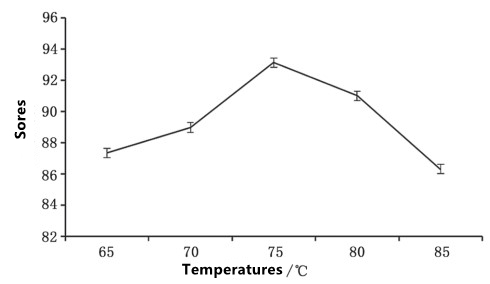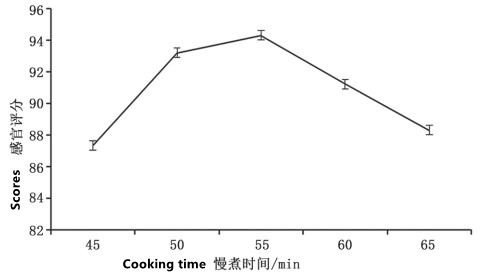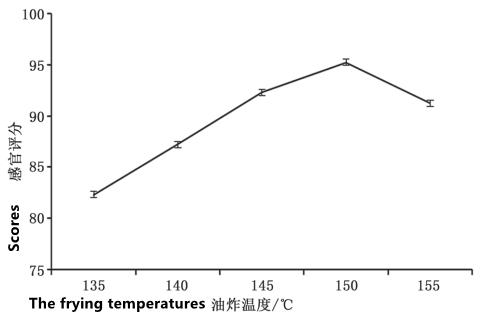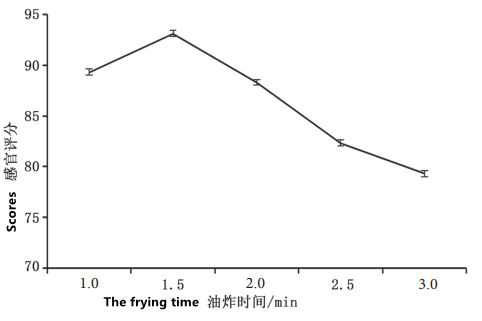Research On Optimization of Sweet Duck By Sous-vide Cooking (Part Two)
2. Results and analysis
2.1 Single factor experimental results and analysis
2.1.1 The effect of slow cooking temperature on sensory quality of sweet duck
Slow cooking temperature is the key to sous-vide cooking. By heating meat below normal cooking temperature, it can effectively avoid the loss of moisture and nutrients in meat. According to the analysis in Figure 1, it is found that with the increase in heating temperatures, the sensory score of sweet duck shows a trend of increasing first and then decreasing. Comprehensive analysis shows that when the temperature is 75℃, its quality is the best, and 70 ℃, 75 ℃ and 80 ℃ are selected as Orthogonal experiments and were performed at 3 levels of this factor.

Figure 1 The effect of slow-cooking temperature on sensory scores of sweet duck
2.1.2 The effect of slow cooking time on sensory quality of sweet duck
Time is the main factor affecting the cookness of low-temperature vacuum cooking. In the process of slow cooking, the duck is gradually cooked by a sous-vide cooker. The longer the time is, the better the fiber is cooked, forming good texture and giving people a smooth and tender taste. Through the analysis in Figure 2, it was found that in the slow cooking process, the sensory score of the sweet duck cooked at a low temperature increased first with the slow cooking time, and the sensory score was the highest when the slow cooking time was 55 minutes. With the increase in slow-cooking time, the sensory scores began to decline. For a comprehensive analysis, slow-cooking for 50 minutes, 55 minutes and 60 minutes was selected as the three levels of this factor to conduct orthogonal experiments.

Figure 2 The effect of slow cooking time on sensory scores of sweet duck
2.1.3 The effect of frying temperature on sensory of sweet duck
After the sweet duck is slow-cooked, uniformly put syrup on it. The main purpose is to use the caramelization reaction of sugar. In the frying process, different oil temperatures will have a certain impact on the degree of caramelization reaction. In addition, the degree of caramelization reaction also affects the sweetness and crispness of the skin of sweet duck. Through the analysis in Figure 3, it was found that in the heating process, the sensory score has been on an upward trend, reaching the highest value at a temperature of 150°C, indicating that the sweet duck fried at this frying temperature has the best quality. The evaluation at a temperature of 135℃ scored the lowest, mainly because it could not effectively promote the caramelization reaction, and it was difficult to form a bright red color and crispness for the skin of sweet duck. After a comprehensive analysis, the frying temperatures of 145 ℃, 150 ℃ and 155 ℃ were selected as the third level of orthogonal experiment.

Figure 3 The effect of the frying temperature on the sensory score of sweet duck
2.1.4 The effect of frying time on sensory quality of sweet duck
The frying time not only affects the brightness of the skin of the sweet duck, but also affects the texture of the sweet duck. If the time is too short, the caramelization reaction will be insufficient, resulting in a less expected color. Crispy skin is not easily formed for the duck. If the frying time is too long, the color is too dark, and the caramelization reaction is too much. There will be a bitter taste, and the surface will be burnt. Through the analysis in Figure 4, it is found that the sensory quality for frying for 1.5 minutes is the best. With the increase in frying time, the sensory score shows a downward trend. After a comprehensive analysis, 1.0 minutes, 1.5 minutes and 2.0 minutes are selected as the three levels of orthogonal experiment of this factor.

Figure 4 The effect of frying time on sensory scores of sweet duck
2.2 Orthogonal experimental results
In the process of making sweet duck by sous-vide cooking, slow cooking temperature, slow-cooking time, frying temperatures and frying time are the key factors that affect the quality of the sous-vide sweet duck. Through the analysis of Table 3 and Table 4, it can be seen that the frying time has the greatest impact on the quality of sweet duck, mainly because frying is the final process, and the frying time directly affects the color and texture of sweet duck. The slow-cooking temperature of the sous-vide cooking is the most direct factor affecting the quality of the duck, followed by the frying temperature and the slow-cooking time. From the orthogonal experiment results in Table 3 and the variance analysis in Table 4, it can be seen that the best technological combination of sous-vide cooking sweet duck is A2B1C2D1, and the sensory score is 97.23, that is, the slow-cooking temperature was 75°C, the slow-cooking time 50 minutes, the frying temperature 150°C, and the frying time 1 min.
Table 3 Orthogonal experiment results
2.1 Single factor experimental results and analysis
2.1.1 The effect of slow cooking temperature on sensory quality of sweet duck
Slow cooking temperature is the key to sous-vide cooking. By heating meat below normal cooking temperature, it can effectively avoid the loss of moisture and nutrients in meat. According to the analysis in Figure 1, it is found that with the increase in heating temperatures, the sensory score of sweet duck shows a trend of increasing first and then decreasing. Comprehensive analysis shows that when the temperature is 75℃, its quality is the best, and 70 ℃, 75 ℃ and 80 ℃ are selected as Orthogonal experiments and were performed at 3 levels of this factor.

Figure 1 The effect of slow-cooking temperature on sensory scores of sweet duck
2.1.2 The effect of slow cooking time on sensory quality of sweet duck
Time is the main factor affecting the cookness of low-temperature vacuum cooking. In the process of slow cooking, the duck is gradually cooked by a sous-vide cooker. The longer the time is, the better the fiber is cooked, forming good texture and giving people a smooth and tender taste. Through the analysis in Figure 2, it was found that in the slow cooking process, the sensory score of the sweet duck cooked at a low temperature increased first with the slow cooking time, and the sensory score was the highest when the slow cooking time was 55 minutes. With the increase in slow-cooking time, the sensory scores began to decline. For a comprehensive analysis, slow-cooking for 50 minutes, 55 minutes and 60 minutes was selected as the three levels of this factor to conduct orthogonal experiments.

Figure 2 The effect of slow cooking time on sensory scores of sweet duck
2.1.3 The effect of frying temperature on sensory of sweet duck
After the sweet duck is slow-cooked, uniformly put syrup on it. The main purpose is to use the caramelization reaction of sugar. In the frying process, different oil temperatures will have a certain impact on the degree of caramelization reaction. In addition, the degree of caramelization reaction also affects the sweetness and crispness of the skin of sweet duck. Through the analysis in Figure 3, it was found that in the heating process, the sensory score has been on an upward trend, reaching the highest value at a temperature of 150°C, indicating that the sweet duck fried at this frying temperature has the best quality. The evaluation at a temperature of 135℃ scored the lowest, mainly because it could not effectively promote the caramelization reaction, and it was difficult to form a bright red color and crispness for the skin of sweet duck. After a comprehensive analysis, the frying temperatures of 145 ℃, 150 ℃ and 155 ℃ were selected as the third level of orthogonal experiment.

Figure 3 The effect of the frying temperature on the sensory score of sweet duck
2.1.4 The effect of frying time on sensory quality of sweet duck
The frying time not only affects the brightness of the skin of the sweet duck, but also affects the texture of the sweet duck. If the time is too short, the caramelization reaction will be insufficient, resulting in a less expected color. Crispy skin is not easily formed for the duck. If the frying time is too long, the color is too dark, and the caramelization reaction is too much. There will be a bitter taste, and the surface will be burnt. Through the analysis in Figure 4, it is found that the sensory quality for frying for 1.5 minutes is the best. With the increase in frying time, the sensory score shows a downward trend. After a comprehensive analysis, 1.0 minutes, 1.5 minutes and 2.0 minutes are selected as the three levels of orthogonal experiment of this factor.

Figure 4 The effect of frying time on sensory scores of sweet duck
2.2 Orthogonal experimental results
In the process of making sweet duck by sous-vide cooking, slow cooking temperature, slow-cooking time, frying temperatures and frying time are the key factors that affect the quality of the sous-vide sweet duck. Through the analysis of Table 3 and Table 4, it can be seen that the frying time has the greatest impact on the quality of sweet duck, mainly because frying is the final process, and the frying time directly affects the color and texture of sweet duck. The slow-cooking temperature of the sous-vide cooking is the most direct factor affecting the quality of the duck, followed by the frying temperature and the slow-cooking time. From the orthogonal experiment results in Table 3 and the variance analysis in Table 4, it can be seen that the best technological combination of sous-vide cooking sweet duck is A2B1C2D1, and the sensory score is 97.23, that is, the slow-cooking temperature was 75°C, the slow-cooking time 50 minutes, the frying temperature 150°C, and the frying time 1 min.
Table 3 Orthogonal experiment results
| Items | A Slow cooking temperature | B Slow cooking time | C Frying temperature | D Frying time | Sensory scores |
| 1 | 1 | 1 | 1 | 1 | 93.23 |
| 2 | 1 | 2 | 2 | 2 | 87.23 |
| 3 | 1 | 3 | 3 | 3 | 86.32 |
| 4 | 2 | 1 | 2 | 3 | 93.25 |
| 5 | 2 | 2 | 3 | 1 | 96.23 |
| 6 | 2 | 3 | 1 | 2 | 89.32 |
| 7 | 3 | 1 | 3 | 2 | 87.21 |
| 8 | 3 | 2 | 1 | 3 | 89.36 |
| 9 | 3 | 3 | 2 | 1 | 94.25 |
| K1 | 88.9267 | 91.2300 | 90.6367 | 94.5700 | |
| K2 | 92.93333 | 90.9400 | 91.5767 | 87.9200 | |
| K3 | 90.2733 | 89.9633 | 89.9200 | 89.6433 | |
| R | 4.0067 | 1.2667 | 1.6567 | 6.6500 |
Table 4 The analysis of the variance table
| Variance sources | Deviation sum of squares | Degrees of freedom |
Variance |
F values |
Significant levels |
| Slow cooking temperature | 24.9245 | 2 | 12.4622 | 7.334 | ** |
| Frying temperature | 4.1745 | 2 | 2.0872 | * | |
| Frying time | 71.4453 | 2 | 35.7227 | ** | |
| Error e | 2.6224 | 2 | 1.3112 | ||
| Correction error e | 6.7969 | 4 | 1.6992 | ||
| Sum | 103.167 |
Please note that ** indicates extremely significant difference P being less than 0.01; * indicates significant difference P being less than 0.05.
2.3 The comparative analysis of the quality of sweet duck by low-temperature vacuum cooking and traditional methods
2.3.1 Comparative analysis of sensory evaluation
According to the comparative analysis of sensory evaluation results in Figure 5, it can be seen that the sensory evaluation results of the color and tissue state of the sweet duck prepared by sous-vide cooking are significantly better than those of the sweet duck prepared by the traditional cooking methods. The main reason is that long-term high-temperature heating has a great impact on the skin and texture of the sweet duck, while sous-vide cooking can effectively alleviate the quality changes caused by heating in the cooking process. The sensory evaluation scores of sweet duck prepared by the two cooking methods were similar in taste, indicating that the two cooking methods had little influence on the taste of sweet duck. The aroma index of sweet duck prepared by sous-vide cooking is significantly lower than that of sweet duck prepared by traditional cooking, mainly because low-temperature cooking is not conducive to the formation of aroma. To sum up, the two cooking methods have their advantages. Sous-vide cooking can effectively improve the sensory quality of the finished product. It is slightly worse in aroma, but has little effect on the overall sensory quality.

Figure 5 Sensory evaluation results
2.3.2 The comparative analysis of cooking loss rates
The cooking loss rate mainly reflects the loss of moisture in meat in the cooking process. Through the analysis in Table 5, the cooking loss rate of sweet duck prepared by sous-vide cooking is significantly lower than that of sweet duck prepared by traditional cooking methods, which is mainly because the high-temperature heating of traditional cooking methods makes the duck contain a lot of moisture in the heating process and causes the duck to lose its moisture. Compared with traditional cooking methods, sous-vide cooking enhances the water keeping of the duck.
Table 5 Cooking loss rates
| Cooking methods | Cooking loss rates/% |
| Traditional cooking methods | 18.65±0.65 |
| Sous-vide cooking | 15.21±0.32 |
2.3.3 Determination of Volatile Base Nitrogen (TVB-N)
Through the analysis in Table 6, the TVB-N values of sweet duck prepared by the two cooking methods are all within the safe range. The TVB-N value of sweet duck prepared by traditional cooking methods is higher than that of sweet duck prepared by sous-vide cooking, mainly because the TVB-N value is related to the heating temperature. In the heating process of the same cooking material, the higher the heating temperature is, the higher the value becomes.
Table 6 TVB-N values
| Cooking methods | TVB-N values (mg/100 g) |
| Traditional cooking methods | 7.31±0.21 |
| Sous-vide cooking | 6.28±0.19 |
3. Conclusion
The production process of sweet duck was optimized by single-factor experiment and orthogonal experiment, and the optimal process parameters of low-temperature cooking sweet duck were finally determined: the slow cooking temperature was 75℃, slow cooking time 50 minutes, frying temperature 150℃, and the frying time 1 minute; the sensory score of the sous-vide sweet duck with a sensory score of 97.23 was the best. Under this condition, the quality difference of finished products prepared by sous vide cooking and traditional cooking methods was analyzed, and it was found that sweet duck cooked by low-temperature cooking had a better sensory evaluation, lower cooking loss rate, and volatile base nitrogen (TVB-N) value in line with the national food hygiene standard (GB 2707-2016) than that of traditional cooking methods. This study provides a theoretical reference for preparing sweet duck by low-temperature cooking, and also provides a reference for the application of low-temperature cooking for other products.
